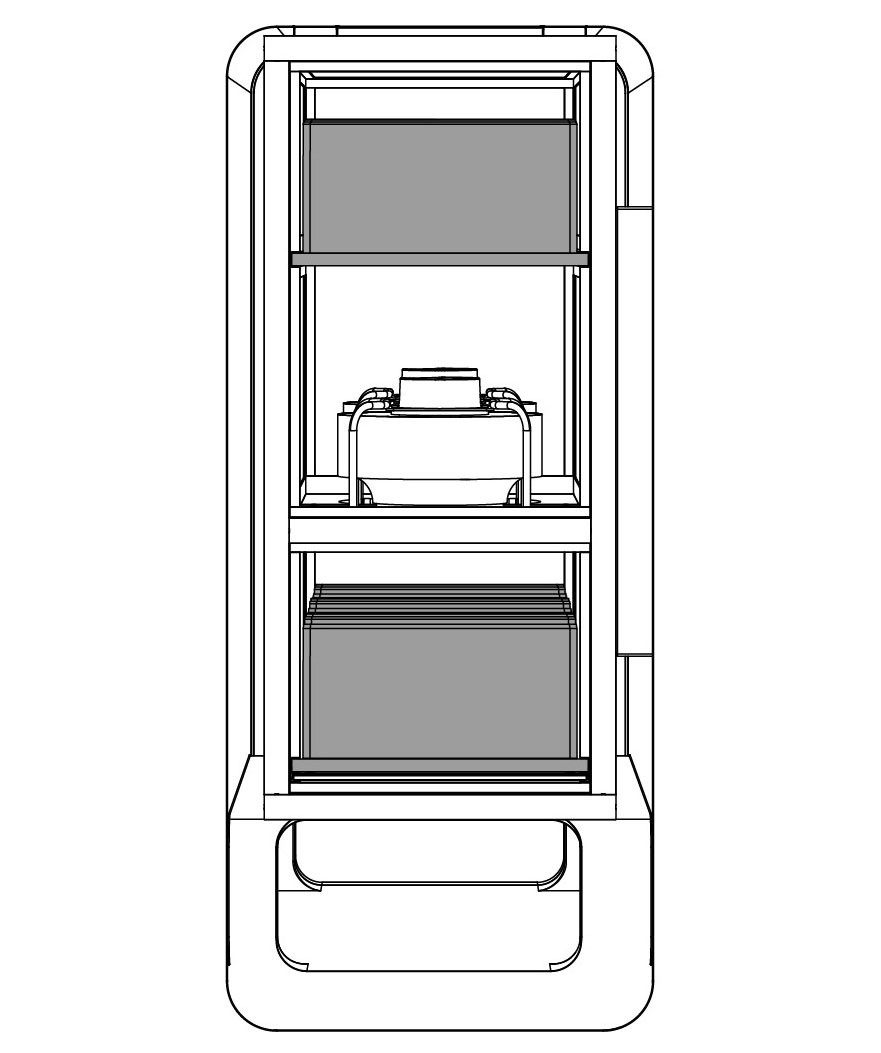Have a break
in fresh air
Relaxed stay in public indoor spaces
The invisible threat of airborne viruses is far from over. People want to feel safe when they stroll through shopping centres, attend concerts and exhibitions, go about their work or use leisure and sports centres. Even when travelling - be it by plane, train or ship or on public transport, where contact with many people is unavoidable - it must be possible to breathe deeply without worrying about the risk of infection.
Effective air purification is the key to minimising the risk of infection with virus-containing aerosols indoors, as has been demonstrated in numerous studies. In premises where permanently installed ventilation and air-conditioning systems are lacking or provide only insufficient air quality, professional mobile air purifiers are a good solution.
Product
Island solution
A relaxing break indoors in freshly purified air
With its optimised roof for the island solution, the M-8 air filter ensures a continuous flow of freshly purified air in the breathing zone around the seating island.
The removal of aerosols containing viruses is done with HEPA filters, which are mainly used in the medical sector. They guarantee a filtering performance of viruses and bacteria of at least 99.95 percent. With a volume flow of up to 8,000 cubic metres per hour, the M-8 reliably reduces virus concentrations.
In addition to the full volume flow rate, which can be set as desired, the unit has two preset power levels with reduced noise development for effective air filtration in public areas.
The air purifier is mobile, easy to maintain, energy-efficient and can be operated remotely via app on any mobile device.
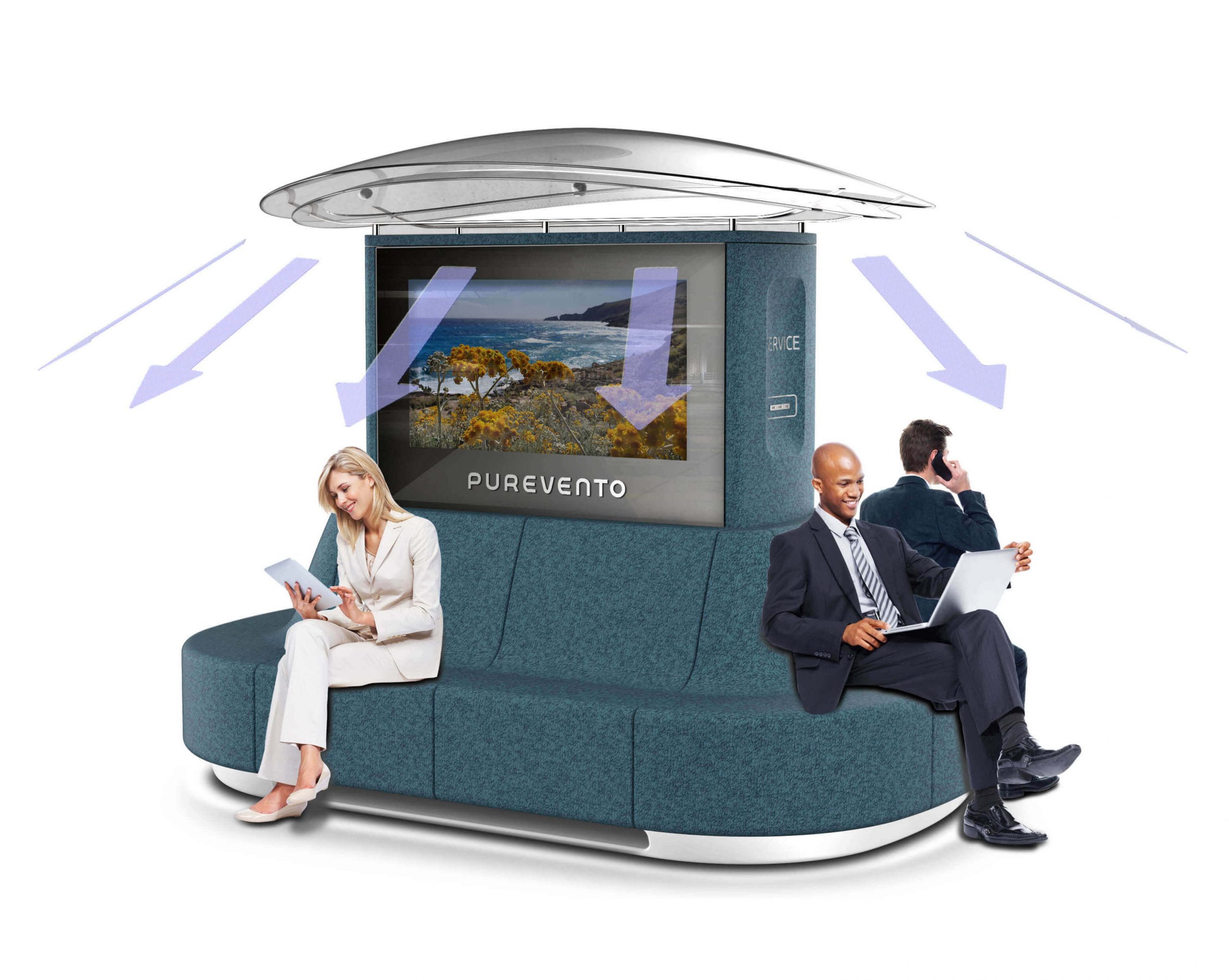
Optional equipment
- Large displays for infotainment and advertising
- Customer services such as charging station for mobile devices and WLAN access
- Seating furniture to match the ambience
- Colour scheme in corporate design with company logo
Applications
On tour in the city
Enjoy a lively city in all weathers
In industrialised countries, roughly 3 out of 4 people already live in cities today, and forecasts predict an increase to 8 out of 10 until 2050. This means that it will become increasingly crowded at all mobility, shopping and meeting points in our cities. This is especially true for popular destinations for city tourism, metropolises and business centres. In parallel to the rising number of people, the risk of infection with virus-containing aerosols is also increasing.
People want to discover the manifold public, commercial, cultural and culinary range and to use indoor offerings in a relaxed manner, there needs to be sufficient meeting places and relaxation zones indoors with effective ventilation.
Meeting point Fresh air island
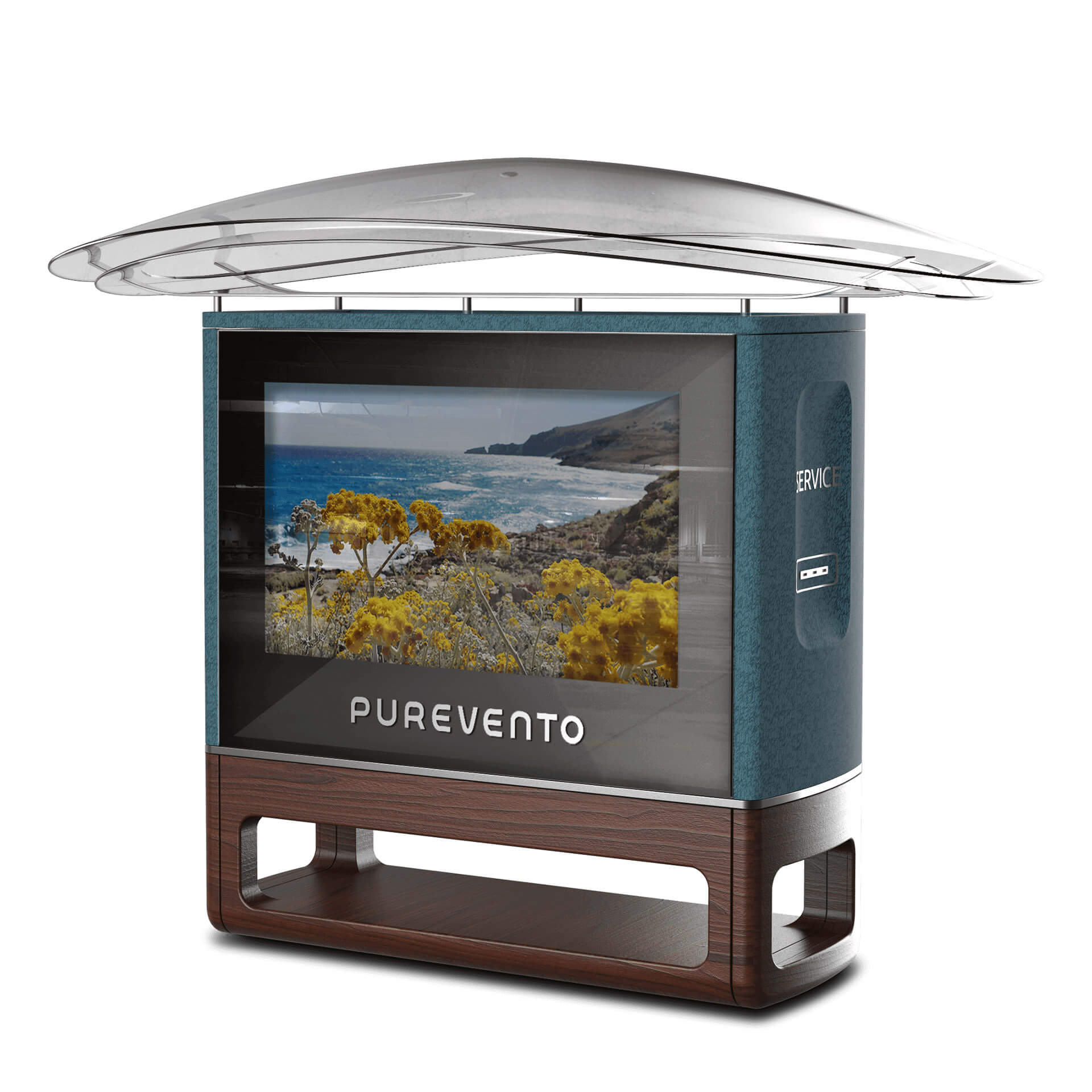
The meeting and information point with integrated services such as WLAN access and charging options for mobile communication devices turns the waiting time for friends, family or colleagues in public spaces into a private moment in the middle of the city hustle and bustle.
The meeting point solution enables relaxed waiting in freshly purified air in shopping centres, railway stations and airports, in hotel lobbies, reception halls and business lounges, in canteens and lounges as well as in event rooms, congress and exhibition halls and public buildings.
Break in the Fresh air lounge
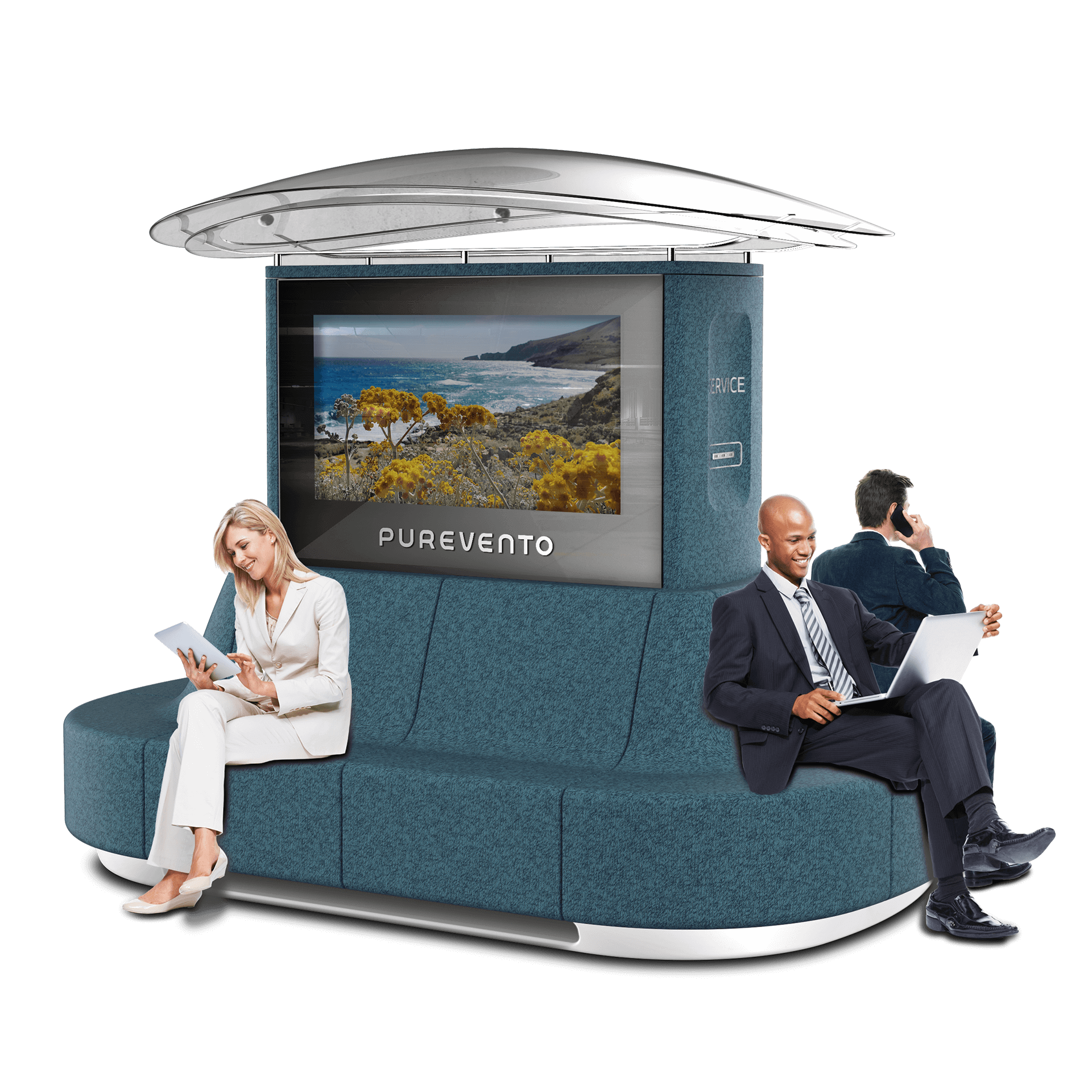
Comfortable seating transforms the break in the public space into a moment of relaxation in the middle of the daily hustle and bustle. Wi-Fi access and charging options for mobile communication devices and can be used for local cross-channel webshop and showroom marketing.
The stand-alone solution provides recreation zones with freshly purified air in shopping centres and airports, in hotel lobbies, reception halls and business lounges, in canteens and lounges, as well as in assembly, congress and trade fair halls, and in theatres and museums or public buildings.
Working principle
Effective air purification
The M-8 air filter creates local breathing zones with high air quality through the use of HEPA filters and active guidance of the air flows through the roof construction. The special feature of our air filters is the supply of purified air from above, analogous to the airflow in an aircraft. This vertical air flow supports the natural process of sedimentation of airborne particles.
- Purified air is discharged directly into the breathing zone and has no opportunity to mix with contaminated ambient air
- Exhaled air is continuously discharged downwards and directly sucked in by the unit for purification
- Aerosols that are harmful to health do not spread further due to vertical airflow
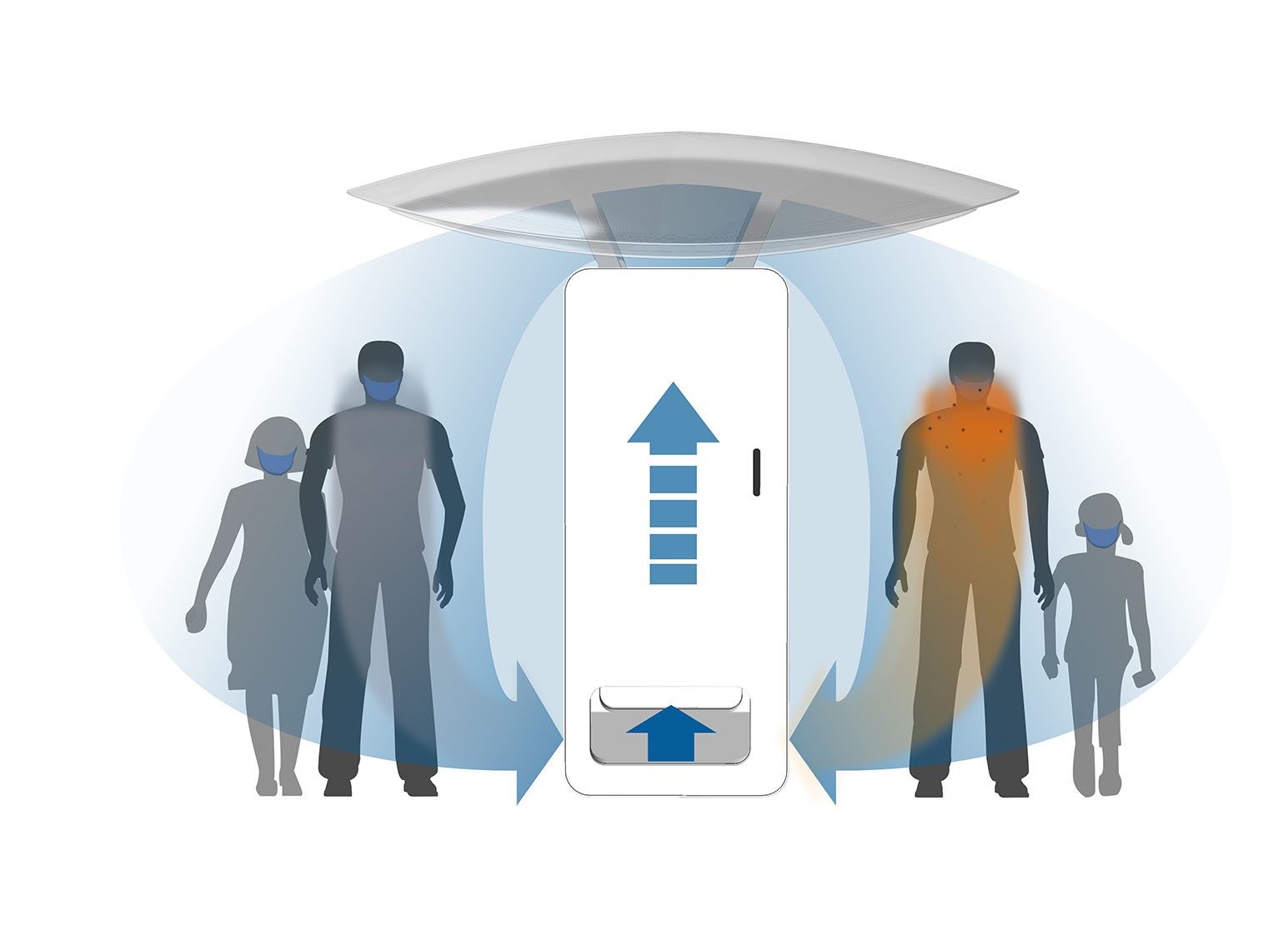
The volume flow of the air purifier M-8 is infinitely variable and offers three optimised performance levels as a presetting:
- Silence mode
Effective cleaning with minimal noise during events and functions - Public mode
Effective cleaning at natural noise levels in shopping centres, public buildings or mobility terminals - Power mode
Highly effective, fast cleaning before and between active periods of use with many people and long duration
Benefits
Affordable health protection
Healthcare and communication platform
Health protection for visitors, customers and staff is particularly important in times of pandemic. The professional air filter M-8 makes an effective contribution to this. At the same time, it offers an additional communication platform for information and advertising.
Health Aspects
- Building trust through a visible investment in effective health protection and customer well-being
- Proof of effective ventilation as a central component of every hygiene concept for obtaining the operating licence
- Sensible supplement to permanently installed HVAC systems for increased protection against infection in all areas with a long period of occupancy and a high number of visitors.
Commercial Aspects
- Proof of effective ventilation as a central component of every hygiene concept for obtaining the operating licence
- Effective contribution to operational risk management as an active preventive measure for occupational health and safety
- Flexible solution with potential for adaptation thanks to modular design and mobility (plug & play)
- Financing through own or third-party advertising via integrated info screens
Technology
Innovative solution with proven technologies
Effective airflow with innovative roof design
When procuring air purifiers, care must be taken to ensure that they are sufficiently dimensioned for the room and application under consideration to significantly reduce the particle and virus load. The air flow rate of the device is of greater importance than the pure efficiency of the filter, says the Society for Aerosol Research in its "Position Paper on Understanding the Role of Aerosol Particles in the SARS Cov-2 Infection Event" of December 2020.
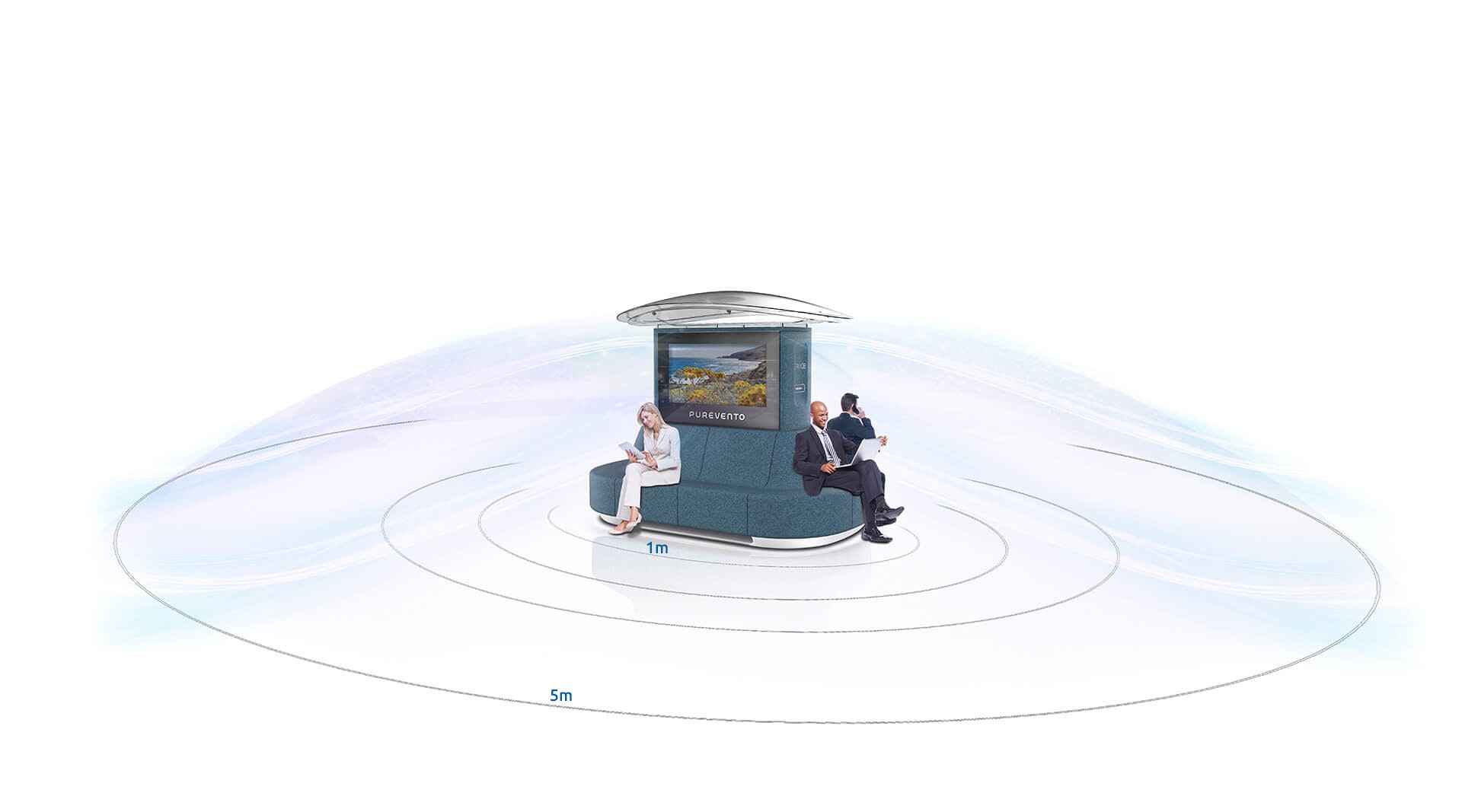
With a volume flow of 4,000 cubic metres per hour, the M-8 air purifier can reduce the virus load by 81 percent within a radius of 5 metres.
Basically, an air exchange rate of 6, i.e. filtering the entire room air volume six times an hour with HEPA filters, is sufficient to minimise the risk of infection.
Effective filtering
The purification of the sucked-in air from viruses and bacteria takes place in a two-stage filter system:
- Filtering infectious aerosols with HEPA filters
HEPA filters have the advantage that, in addition to aerosols containing viruses and bacteria, they also filter ultra-fine dusts from the ambient air, which can penetrate deep into the lungs and increase susceptibility to respiratory diseases. The filter efficiency is at least 99.95 percent according to EN 1822 and ISO 29463. - Increasing filter efficiency with fine dust pre-filters
Upstream fine dust filters ensure that the service life of the high-quality HEPA filters is increased. - Optional disinfection of viruses in the unit
If desired, the viruses in the unit can be deactivated by means of UVC light.
Advantages
Overview
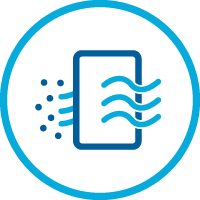
Effective
Effective prevention of the spread of virus-containing aerosols with HEPA filters


Modular
Effective stand-alone solution with optional equipment including seating area
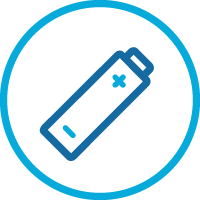
Efficient
Minimised operating and maintenance costs due to demand-oriented design with preselection stages

Mobile
Plug & Play with connection option to the standard power supply
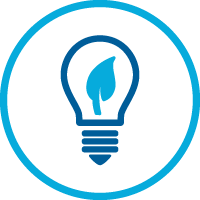
Intelligent
Sophisticated combination of patent-pending innovations and proven technologies

Low noise
Optimised air purification with minimal noise level


Effective
Effective prevention of the spread of virus-containing aerosols with HEPA filters

Modular
Effective stand-alone solution with optional equipment including seating area

Efficient
Minimised operating and maintenance costs due to demand-oriented design with preselection stages

Mobile
Plug & Play with connection option to the standard power supply

Intelligent
Sophisticated combination of patent-pending innovations and proven technologies

Low noise
Optimised air purification with minimal noise level
Customized solution
Modular and scalable
The stand-alone air purification island solution provides a local protection zone thanks to effective indoor air purification in accordance with the statement of the Commission on Indoor Air Hygiene (IRK) at the Federal Environment Agency dated 12.8.2020.
- Adaptation of the air flow rate to local conditions and room occupancy
- Detection of airflow and air conduction in the room
Choose the right equipment for your stand-alone solution.
We are happy to consult you: sales@purevento.com
FAQs
Frequently asked questions
How do viruses (e.g. SARS-CoV-2) and bacteria spread?
Leading virologists have discovered that almost half of the risk of infection is due to droplets that are emitted when breathing and speaking, and to a greater extent when sneezing or coughing. They fall to the ground in a radius of about 1.50 metres.
Aerosols play a major role in the spread of COVID-19. They consist of tiny virus-containing particles that remain in the air like fine dust, swirl and are transported over long distances. They are contagious for several hours. To become infected, it is sufficient to breathe in the virus-contaminated air after the infected person has been in the room. Transmission through aerosols has also been proven for measles, tuberculosis, influenza and Sars-CoV-1.
How can the risk of infection via aerosols in the air be effectively reduced?
According to recommendations of the WHO and the German Robert Koch Institute, distancing and face masks help to prevent the risk of infection through droplets and aerosols. However, only FFP2/3 masks, which are mainly used in the medical sector, offer effective protection. In closed indoor rooms, effective ventilation is therefore crucial to minimise the risk of infection from aerosols containing viruses in the air.
There is a ventilation system. How well can it reduce the risk of infection?
Permanently installed ventilation and air-conditioning systems (HVAC) can contribute to reducing the risk of infection. This is all the greater the more fresh air is supplied - ideally 100 per cent outside air. This dilutes the existing room air and thus reduces the concentration of virus-containing aerosols in the breathing air.
The key figure for air quality in this process is the air exchange rate, which describes how often the total air volume in a room should be replaced with fresh air in one hour. The prescribed air exchange rates for public rooms of 4 - 8 times per hour are based on general pollutants in the air such as the CO2 concentration.
Can the risk of infection be eliminated with a high air exchange rate?
So far, it is not certain what concentration of viruses triggers an infection. In the medical field, where viruses had to be considered exclusively up to now, significantly higher air exchange rates of 12 - 15 times per hour apply. According to Lufthansa, this increased air exchange rate is also used in the aircraft.
In addition, HEPA filters are used in the aeroplane for air purification, as prescribed in the medical sector, and the air flow is guided vertically from top to bottom in order to remove exhaled aerosols containing viruses from the breathing zone as quickly as possible and to minimize the risk of infection from person to person.
Even a single infectious person can possibly spread enough virus-containing aerosols to infect the people in their immediate vicinity or even via the room air. The longer the time spent next to a person infected with COVID-19, e.g. in queues or in closed rooms, the higher the risk of infection. Indoors without a face mask, there is an increased risk of infection from virus-containing aerosols despite dilution ventilation.
The air exchange rate also says nothing about how the air flows of supply and exhaust air from the occupied and breathing zones are distributed in the room, i.e. about the ventilation-induced dispersion behaviour of virus-containing aerosols in the room air: the further infected aerosols spread in the room, the higher the risk that the concentration of dangerous aerosols in the room will increase overall and thus also the risk of infection.
How are viruses filtered out of the air?
Viruses and bacteria are emitted together with aerosols, i.e. tiny particles that can float and swirl in the air. These aerosols are usually larger than 1 micron.
Aerosols containing viruses can be removed from the air stream with a HEPA filter. This filter technology is proven in medical areas. An upstream fine dust filter of class F7 ensures a longer service life of the finer-pored and more expensive HEPA filter. We use certified high-performance filters from renowned manufacturers with international availability.
Are the viruses inactivated in the filter?
Optionally, UVC lamps can be used for disinfection in the unit.
How loud is the air purifier?
As the room size increases, higher volume flows are required to remove airborne viruses and bacteria from the existing room air by means of HEPA filters. This is accompanied by an increase in fan noise.
The air filter is designed in such a way that the optimum cleaning performance for two typical areas of use - conversations and public traffic in public spaces - simultaneously meet the requirements for noise emissions and enable efficient operation.
What kind of connection does the unit need?
The indoor air filter requires a standard household 230 volt power connection and can be put into operation immediately.
How high are the running costs?
The running costs consist of the electricity costs depending on the duration and intensity of use. In addition, there are the filter changes according to the recommendations of the filter manufacturers. The proper functioning of the filter system is continuously monitored telemetrically. The filters have to be changed approximately every six months.
How are the air filters controlled?
The air filters are controlled via app using mobile end devices. For regular operating times - e.g. during the opening hours of a shopping centre - the operating mode can be defined for different time periods and controlled automatically. The technical key figures are recorded telemetrically and monitored automatically. An alarm function ensures that any malfunctions are immediately detected and can be remedied.

